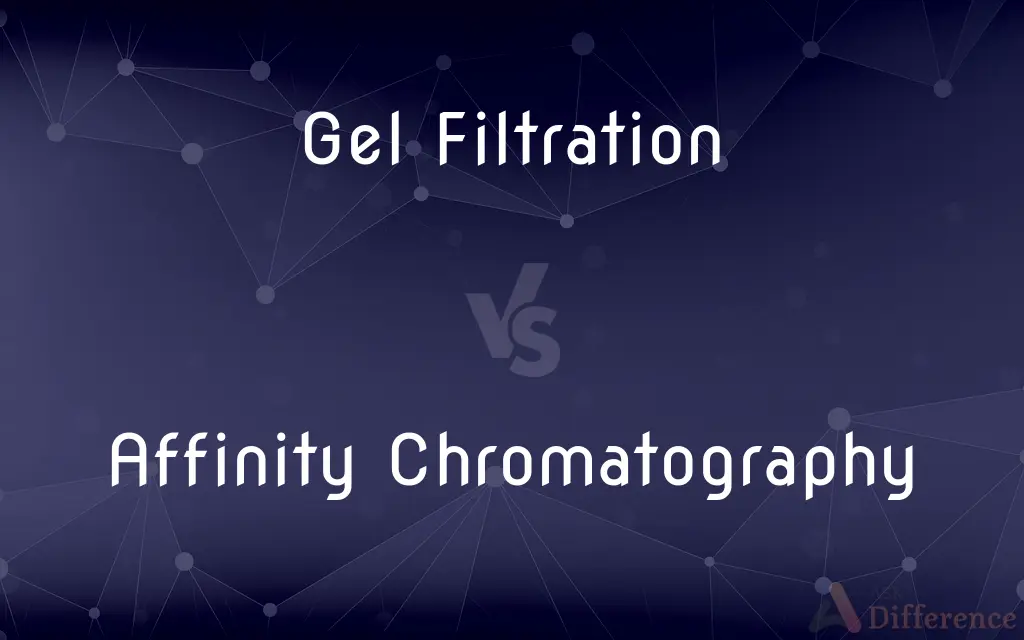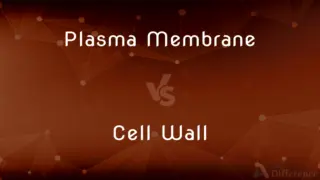Gel Filtration vs. Affinity Chromatography — What's the Difference?
By Tayyaba Rehman — Published on January 10, 2024
Gel Filtration, also known as size-exclusion chromatography, separates molecules based on size. Affinity Chromatography separates biomolecules based on specific binding interactions between a molecule and a target ligand.

Difference Between Gel Filtration and Affinity Chromatography
Table of Contents
ADVERTISEMENT
Key Differences
Gel Filtration Chromatography involves a stationary phase composed of porous beads. Molecules in a mixture are separated based on their size, with larger molecules eluting first as they cannot enter the small pores of the beads. In Affinity Chromatography, the stationary phase is coated with a ligand that specifically binds to a target molecule (e.g., antibody, enzyme), enabling selective separation.
In Gel Filtration, no specific interactions occur between the stationary phase and the molecules being separated. Its primary purpose is to separate molecules based on their differential access to the pores. Affinity Chromatography, however, relies on specific and strong interactions between the target molecule and a ligand, leading to highly selective separation.
Gel Filtration is often used for desalting, buffer exchange, or size-based purification of proteins and nucleic acids. It is a gentle method that maintains the native state of biomolecules. Affinity Chromatography is widely used for purifying specific proteins or nucleic acids, capturing enzymes, antibodies, or receptors.
The efficiency of Gel Filtration is influenced by factors like the molecular weight and shape of the sample molecules, while the effectiveness of Affinity Chromatography depends on the strength and specificity of the interaction between the target molecule and the ligand.
While Gel Filtration is a versatile and straightforward method for size-based separation, Affinity Chromatography is more specialized, often requiring the design of specific ligands or antibodies for the target molecule, making it a powerful tool for purifying specific biomolecules.
ADVERTISEMENT
Comparison Chart
Separation Principle
Based on molecular size.
Based on specific binding interactions.
Stationary Phase
Porous beads.
Coated with specific ligands or antibodies.
Application
Desalting, buffer exchange, size purification.
Purifying specific proteins, capturing enzymes.
Selectivity
Non-specific, size-dependent.
Highly specific to target molecules.
Use in Research
Broad and versatile for size separation.
Targeted for specific molecule purification.
Compare with Definitions
Gel Filtration
Utilizes porous beads in the stationary phase.
The porous beads in gel filtration allowed smaller molecules to elute later.
Affinity Chromatography
Uses ligand-coated stationary phase for selective binding.
The stationary phase in affinity chromatography was coated with an antigen to capture specific antibodies.
Gel Filtration
Non-specific separation method based on molecular size exclusion.
Gel filtration was ideal for the non-specific separation of the nucleic acid mixture.
Affinity Chromatography
Used for high-purity biomolecule isolation.
The research team used affinity chromatography for high-purity extraction of recombinant proteins.
Gel Filtration
Separates molecules based on size.
Gel filtration was used to separate proteins of different molecular weights.
Affinity Chromatography
Requires specific ligand-target molecule interaction.
Affinity chromatography was effective due to the strong binding between the ligand and the protein.
Gel Filtration
Often used for buffer exchange in protein solutions.
We performed gel filtration for buffer exchange in the antibody solution.
Affinity Chromatography
Ideal for purifying specific target molecules.
We isolated the enzyme using affinity chromatography due to its high specificity.
Gel Filtration
Suitable for gentle separation maintaining biomolecules' native state.
Gel filtration preserved the native structure of the enzymes during purification.
Affinity Chromatography
Separates based on specific molecular interactions.
Affinity chromatography was used to purify antibodies from a serum sample.
Common Curiosities
What is Gel Filtration used for?
Primarily for separating biomolecules based on size differences.
Is Affinity Chromatography suitable for large-scale purification?
Yes, especially when purifying a specific target molecule.
Can Gel Filtration separate molecules of similar size?
It's less effective for molecules of very similar sizes.
Can Gel Filtration be used for desalting?
Yes, it's commonly used for desalting and buffer exchange.
Can Affinity Chromatography be automated?
Yes, there are automated systems for large-scale affinity purification.
What types of ligands are used in Affinity Chromatography?
Enzyme substrates, antibodies, metal ions, and other specific binders.
What is the principle of Affinity Chromatography?
It separates molecules based on specific binding interactions.
How does molecular size affect elution in Gel Filtration?
Larger molecules elute first as they cannot enter the small pores of the beads.
What are the advantages of Affinity Chromatography?
High specificity and purity in isolating target molecules.
How do buffer conditions affect Gel Filtration?
Buffer composition can influence the separation but doesn't affect specificity.
What factors affect the choice of stationary phase in Gel Filtration?
The molecular weight range of the sample and the desired resolution.
How do you choose between Gel Filtration and Affinity Chromatography?
It depends on the specific separation needs: size vs. specificity.
Is Gel Filtration chromatography gentle on proteins?
Yes, it's a gentle method that preserves protein structure and function.
Can Affinity Chromatography capture small molecules?
Yes, if specific ligands for these molecules are available.
What is a common application of Affinity Chromatography?
Purifying proteins, such as enzymes or antibodies, from complex mixtures.
Share Your Discovery

Previous Comparison
Plasma Membrane vs. Cell Wall
Next Comparison
NFA vs. DFAAuthor Spotlight
Written by
Tayyaba RehmanTayyaba Rehman is a distinguished writer, currently serving as a primary contributor to askdifference.com. As a researcher in semantics and etymology, Tayyaba's passion for the complexity of languages and their distinctions has found a perfect home on the platform. Tayyaba delves into the intricacies of language, distinguishing between commonly confused words and phrases, thereby providing clarity for readers worldwide.













































